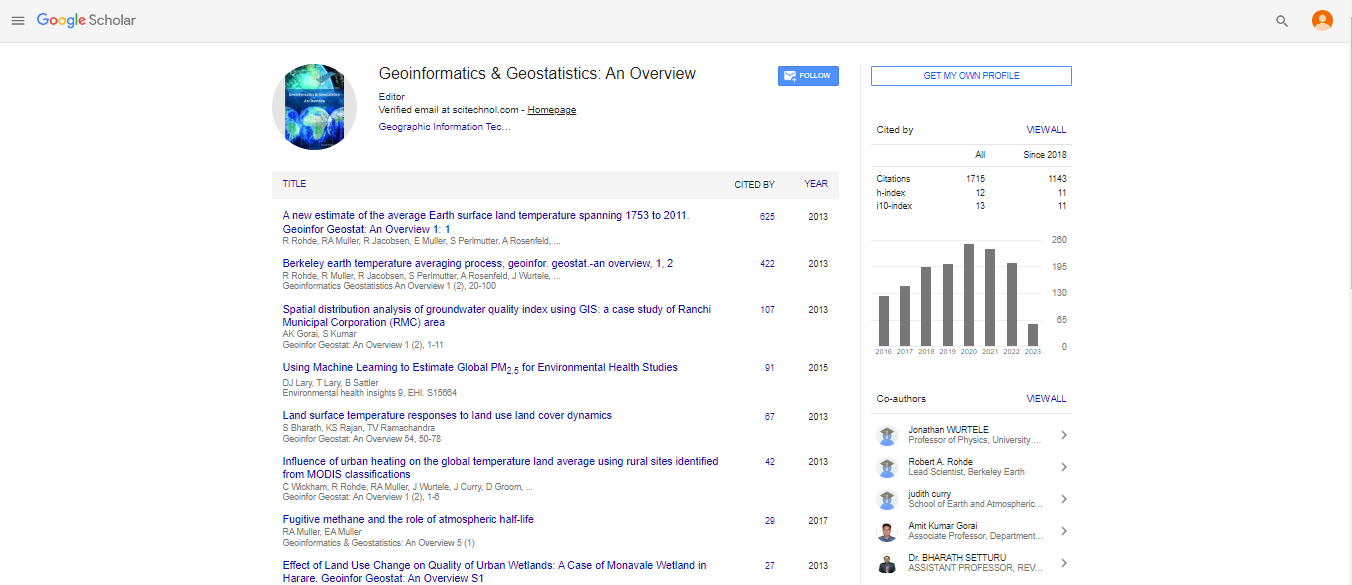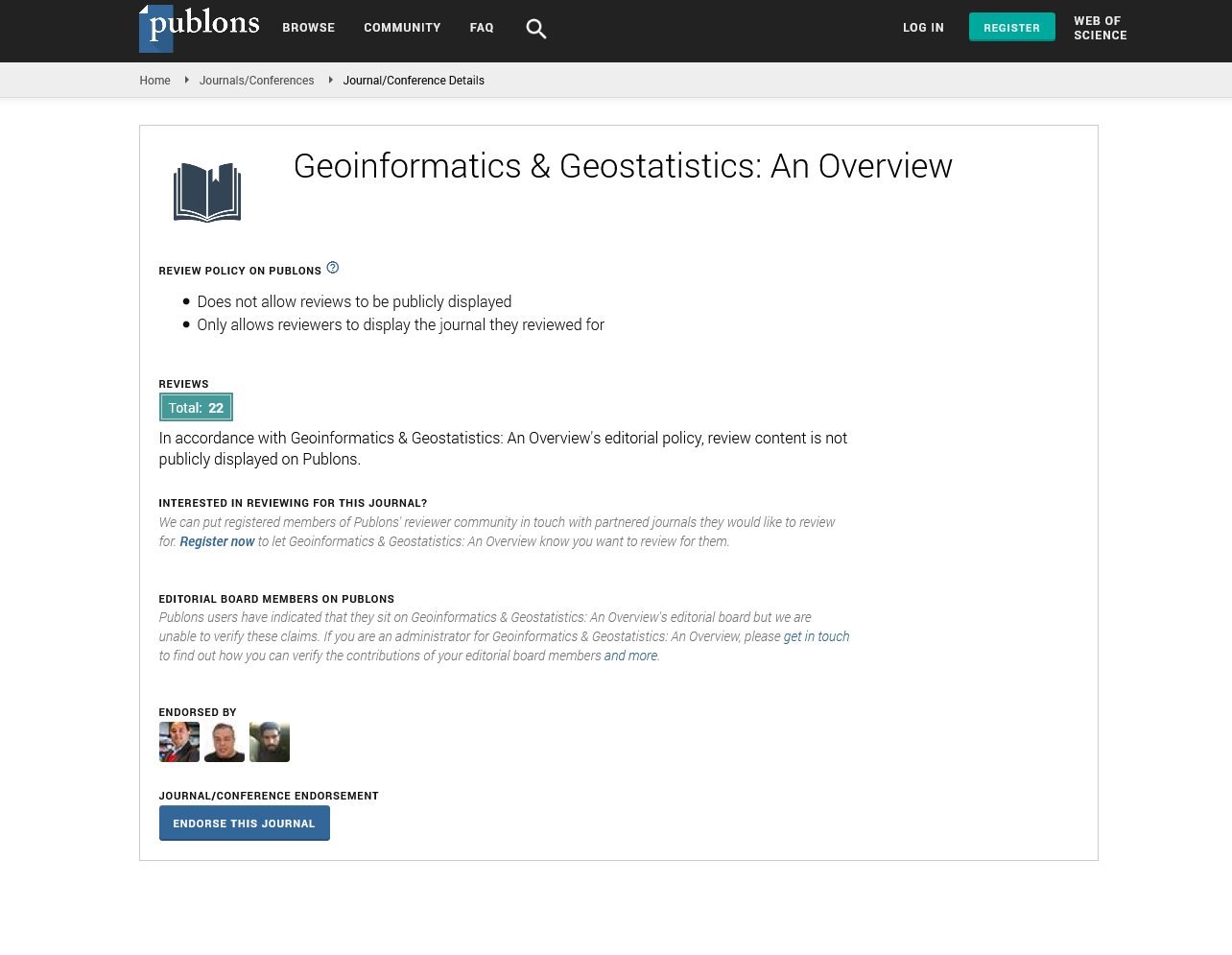Opinion Article, Geoinfor Geostat An Overview Vol: 12 Issue: 5
Applying Machine Learning Methods for Accurate Spatial Interpolation of Environmental Variables
Langley Hart*
1Department of Geospatial Analysis, University of Warsaw, Warsaw, Poland
*Corresponding Author: Langley Hart,
Department of Geospatial Analysis,
University of Warsaw, Warsaw, Poland
E-mail: hartl@uwu.edu.pl
Received date: 23 September, 2024, Manuscript No. GIGS-24-150361;
Editor assigned date: 25 September, 2024, PreQC No. GIGS-24-150361 (PQ);
Reviewed date: 09 October, 2024, QC No. GIGS-24-150361;
Revised date: 16 October, 2024, Manuscript No. GIGS-24-150361 (R);
Published date: 23 October, 2024, DOI: 10.4172/2327-4581.1000415
Citation: Hart L (2024) Applying Machine Learning Methods for Accurate Spatial Interpolation of Environmental Variables. Geoinfor Geostat: An Overview 12:5.
Description
The urgency of transitioning to renewable energy sources is underscored by the pressing challenges of climate change, energy security and the depletion of fossil fuels. As nations strive to increase their renewable energy capacities, identifying suitable locations for installations such as solar, wind and hydroelectric power becomes paramount. Geospatial analysis, utilising Geographic Information Systems (GIS), plays a critical role in this process by allowing for the integration of various data layers to evaluate site suitability based on multiple environmental, social and economic factors. This essay explores the methodologies and benefits of using geospatial analysis in evaluating potential sites for renewable energy installations.
To effectively assess sites for renewable energy, a systematic approach is adopted, encompassing data collection, geospatial analysis and multi-criteria decision-making. The foundation of any geospatial analysis is robust data. Various datasets are collected, including: Digital Elevation Models (DEMs) provide information on land slope and elevation, important for determining solar panel placement and wind turbine height. Satellite imagery and land use classifications help identify existing land uses and potential conflicts with renewable energy installations.
Solar radiation maps and wind speed data are essential for evaluating the viability of solar and wind projects. Hydrological data is also gathered to assess potential sites for hydroelectric power. Data on protected areas, residential zones and infrastructure are included to ensure that proposed sites minimize ecological impact and align with community interests. With data collected, various geospatial analysis techniques are employed Different data layers are overlaid to identify areas where multiple criteria are satisfied, such as high solar radiation combined with minimal land use conflicts.
Buffer zones are created around sensitive areas, such as residential neighborhoods and protected lands, to avoid potential conflicts and environmental degradation. This method integrates various criteria to create a comprehensive suitability map. Each criterion is weighted according to its importance, allowing decision-makers to visualize areas that offer the best potential for renewable energy installations.
The application of geospatial analysis yields detailed suitability maps for different types of renewable energy. The analysis identifies regions with high solar radiation and low shading, indicating optimal locations for solar farms. For instance, areas with minimal vegetation and flat terrain are highlighted, suggesting that approximately 25% of the evaluated region could be developed for solar energy.
Wind speed data reveal zones with average wind speeds exceeding 6 m/s, deemed suitable for wind turbine placement. The analysis indicates that around of the study area is highly suitable for wind energy projects, particularly along ridgelines where wind patterns are favorable. The hydrological assessment uncovers potential sites near rivers and streams with sufficient flow rates, suggesting that 10% of the area could support small-scale hydroelectric installations. Sites are evaluated for environmental impact, ensuring that installations do not disrupt critical habitats.
Buffer analysis effectively identifies key conflict areas where renewable energy installations should be avoided. For example, areas within 1 km of residential neighborhoods are flagged to minimize noise and visual impacts, while protected ecological zones are marked to preserve biodiversity. The integration of geospatial analysis into the site evaluation process for renewable energy installations offers several advantages. By visualizing spatial data and evaluating multiple criteria, stakeholders can make informed decisions that balance energy needs with environmental protection and community concerns.
Geospatial analysis streamlines the site selection process, allowing for quicker identification of suitable locations, ultimately accelerating the development of renewable energy projects. The results of geospatial analyses can be shared with policymakers, urban planners, and community stakeholders, promoting collaboration and transparency in the decision-making process. As technology evolves and new data becomes available, geospatial analysis methodologies can be easily updated to reflect changing conditions, ensuring that site evaluations remain relevant.
Conclusion
Evaluating potential sites for renewable energy installations through geospatial analysis is a powerful approach that combines technical precision with practical relevance. By integrating various data layers and employing sophisticated analytical techniques, stakeholders can identify optimal locations that maximize energy generation while minimizing environmental impact. As the global community continues to seek sustainable energy solutions, the role of geospatial analysis will be important in guiding effective planning and implementation strategies. This integrated approach not only supports the transition to renewable energy but also contributes to the broader goals of sustainability and ecological conservation.
 Spanish
Spanish  Chinese
Chinese  Russian
Russian  German
German  French
French  Japanese
Japanese  Portuguese
Portuguese  Hindi
Hindi 
